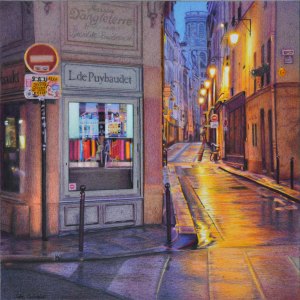Brush and Pencil
I am regularly asked about applying oil pastels with a brush. Here is what I do…

brushes and oil pastel in front of my current work-in-progress.
To apply oil pastel undercoat (as you see in this image) I use a size 1 bristle brush. The brush on the left started off looking like the brush next to it. Its bristles have been eroded by pushing oil pastel pigment onto the Arches Aquarelle paper. However a worn-down brush works just fine for my purpose so I will keep using it until I decide to throw it away. Bristle brushes are inexpensive and easily replaceable. I go through a brush every two or three drawings.
If I only need a dab of colour I take it directly off the pastel with my brush. I don’t even need to take the pastel out of its box to do this.

Taking the colour directly off the pastel while it stays in its box.
If I know I am going to need a lot of one colour or I want to mix colours, I slice bits of pastel off with a palette knife and mix the colours on a palette. (Because the pigment is greasy/sticky pastel I find a ceramic surface makes the best palette ie. a small plate.) Using mixed pastels on a palette is almost exactly like using oil paint. Mixed oil pastel pigment on a palette doesn’t dry out so it can be used next day/next week…no problem.

Applying pastel to paper with a brush is a lot like painting with oils. I plot the areas of colour onto the paper in a general way. All the fine nuances of colour and detail will be put on with coloured pencils when the pastel undercoat is finished.

If I am making a major change of colour (ie. from purple to pale yellow) then I clean the brush thoroughly with solvent, though wiping the brush with tissue paper between colour changes is usually enough. With most colour changes I tend to dry-wipe the brush.
If you look back at the top image you will see the very wide bristle brush. I use this to sweep over pencil AND pastel to blend and soften. A good example is the image below…

“Time and Space”
In the drawing “Time and Space” pencil has been worked into the pastel. I have repeatedly brushed across the drawing with the large bristle brush pushing the pencils and pastels together – merging and softening. Quite often after doing this I will apply more pencil and then repeat the brushing – until I have the effect I want. WARNING: If I brush over the top of the red rose with my wide brush I might get red pigment into the surrounds so I am careful not to do this.
In “Time and Space” I wanted a subtle look so I used Caran d’Ache Neopastels for the background undercoat. They are drier and more gentle than Sennelier pastels. Only for the bold red rose I used Sennelier.
“Day Trip to Giverny” – I also made the choice of using Neopastels for the entire background undercoat except for the foliage closest to the viewer which I undercoated with Sennelier. NB: I don’t slice off bits of Neopastel with a palette knife the way I do with Sennelier. Neopastel, being harder and drier, doesn’t lend itself to being mixed on a palette the way the more buttery soft Sennelier does.

“Day Trip to Giverny”
I find using oil pastels with coloured pencils much more satisfying than using pencils by themselves. I feel this combination is a bridge back towards painting – in fact I have given it the name “dry painting“.
I am often asked if I use fixatives or varnishes with this combination. No, nothing.

“Enchanted April”
November 2017
Sennelier pastels and coloured pencils.
The marriage of oil pastels with coloured pencils gives a work substance and momentum.

The drawing I am working on currently. (early 2018) This is how it looked last week.
You may see the finished drawing on the post Walking with Claude
PS: Don’t worry about getting exact undercoat colours because the coloured pencils over the top will modify the colours to perfection.
A cautionary tale: some artists who use coloured pencils like to brush off pencil dust with a big brush (rather like a brush-and-pan kind of brush). Don’t indiscriminately do this when using oil pastels. Oil pastels are oily and sticky. A piece of pastel dust in the wrong area is likely to smear if you sweep it into your page – and it will not be removable. Instead, blow it off your paper or if your breath isn’t strong enough, simply lift it off gently with the point of a brush, pencil or putty eraser. Simple.
The drawing “A Room with a View” is an example of using only coloured pencils but still using a bristle brush to blend them. No oil pastel is used in this drawing, and yet the result is still ‘painterly’ because of blending with a paint brush.

“A Room with a View” the coloured pencil is blended with a brush.
See also ART MATERIALS page
Another relevant page is MIXED MEDIA IMPRESSIONISM
Night Moves shows another example of this technique, before and after coloured pencil was added to the oil pastels.
Perfect Partners: Luminance and Neocolor shares a slightly different method – without using a brush.





































